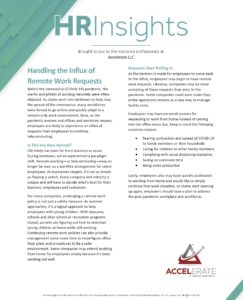Before the coronavirus (COVID-19) pandemic, the merits and pitfalls of working remotely were often debated.
As states went into lockdown to help stop the spread of the coronavirus, many workforces were forced to go online and quickly adapt to a remote-only work environment. Now, as the pandemic evolves and offices and worksites reopen, employers are likely to experience an influx of requests from employees to continue telecommuting.
Is This the New Normal?
Life lately has been far from business as usual. During lockdown, we’ve experienced a paradigm shift. Remote working—or telecommuting—may no longer be seen as a workflex arrangement for select
employees. As businesses reopen, it’s not as simple as flipping a switch. Every company and industry is unique and will have to decide what’s best for their business, employees and customers.
For many companies, prolonging a remote work policy is not just a safety measure. As summer approaches, it’s a logical approach to help employees with young children. With daycares, schools and after-school or recreation programs closed, parents are figuring out how to entertain young children at home while still working. Continuing remote work policies can also provide management some more time to reconfigure office floor plans and procedures to be a safer environment. Some companies may extend working from home for employees simply because it’s been working out well.
Requests Start Rolling In
As the decision is made for employees to come back to the office, employees may begin to have remote work requests. Likewise, companies may be more accepting of those requests than prior to the pandemic. Some companies could even make their entire operations remote as a new way to manage facility costs.
Employees may have personal reasons for requesting to work from home instead of coming into the office every day. Keep in mind the following common reasons:
- Fearing contraction and spread of COVID-19 to family members or their household
- Caring for children or other family members
- Complying with social distancing mandates
- Saving on commute time
- Being more productive
Lastly, employees also may have quickly acclimated to working from home and would like to simply continue that work situation. As states start opening up again, employers should have a plan to address
the post-pandemic workplace and workforce.
Compliance Considerations
If remote work policies weren’t created when employees were sent home to work as the COVID-19 outbreak picked up, they should be now. Make sure your return-to-work or transition plan is consistent with local and state regulations. It’s also important to ensure compliance with the Families First Coronavirus Response Act when responding to workfrom-home requests.
This isn’t a one-size-fits-all situation, and employers should have justified and documented explanations when reviewing and responding to requests. Along with legal and business considerations, employers should keep the following factors in mind when granting work-from-home requests:
- The request is due to an issue related to the Americans with Disabilities Act. If that’s the case, employers should discuss possible reasonable accommodations with the employee.
- The employee has been able to meet expectations while working remotely during the pandemic. If expectations have not been met, consider whether the performance issues can be managed remotely
once the pandemic subsides. - Business needs have changed in a way that physical presence in the workplace is or is not required.
- The company has discovered that productivity has increased. Remote working has been proven to be so effective that the company wants to encourage employees to continue to work remotely, if they’d
like to. - Employers should consider how similar workflex requests have been handled in the past.
Common reasons for denying remote work requests include if the position requires the employee to work in the office or if the employee has had previous disciplinary incidents.
After finalizing a return-to-work plan, the next step for employers is to update all job descriptions to clarify whether positions require working on-site and whether employees are eligible to work remotely. Having those decisions and reasons documented will help managers respond to employees’ requests. Similarly, having those guidelines on paper will help employers respond to prospective employees who are looking for remote work positions or other workflex options. This may also open up the door to recruit from a vast talent pool not restricted by geographic distance from the office.
While working in a post-COVID-19 world, everyone will have to adapt and find what works best to protect employers and employees—whether that’s in or out of an office setting. To learn more about responding to and accommodating remote work requests, contact our Reseco subsidiary Accelerate LLC today at www.accel4biz.com.


